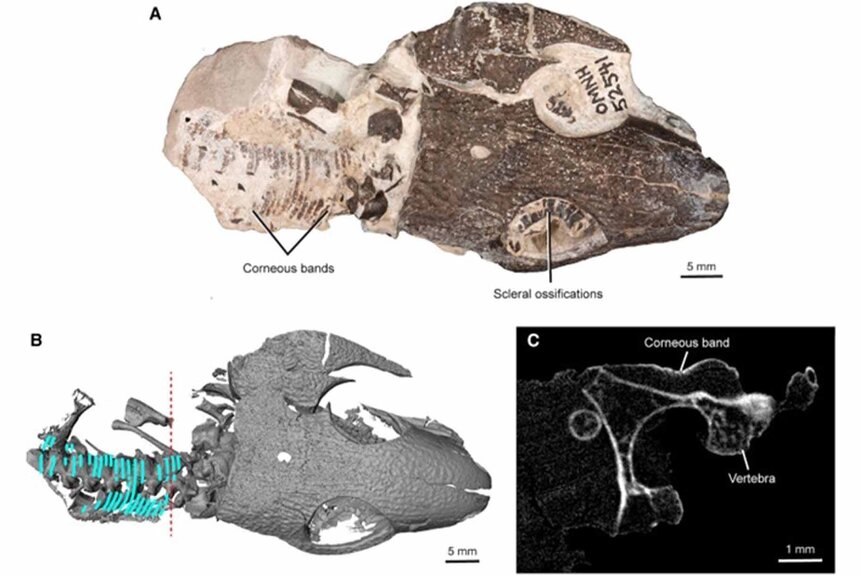Create a free profile to get unlimited access to exclusive videos, sweepstakes, and more!
The Oldest Fossilized Skin Ever Found Predates the Dinosaurs
Oil and clay are the secrets to long-term skin preservation.
The mad geniuses at Jurassic Park (and later, Jurassic World) had to make some assumptions about the dinosaur-shaped creatures they were creating. Paleontology is, by its nature, an exercise in building a complete picture with missing puzzle pieces. They got hold of what genetic and fossil material were available and freestyled the rest.
The fact that we’re not swimming in trillions of fossils, describing the story of life on Earth in excruciating detail, is evidence that preservation of any kind is uncommon. In most cases, an animal dies and is consumed, either by other animals or by microbes and the ravages of time. Only a vanishingly small portion of organisms meet their end in such a way that their bones are preserved and eventually mineralize into stony fossils. An even smaller subset hangs onto soft tissues.
RELATED: These Prehistoric Plant Fossils are Actually Baby Turtles in Disguise
Until recently, the oldest preserved skin samples dated to roughly the beginning of the Cretaceous, about 150 million years ago. Now, a team of scientists have found skin nearly twice that old. The discovery was described in the journal Current Biology.
Preserved Skin Samples Reveal the Armor of Ancient Reptiles
Roughly 400 million years ago, animals took their first steps onto dry land, and when they did, they needed new and improved skin. The coverings that worked so well in the water weren’t necessarily the best for the dryer conditions of the surface. With the expansion into new environments, skin went through a number of variations in order to best serve its purpose of keeping the insides in and the outsides out.
Today, some creatures are smooth skinned while others are knobbly and scaled; some have feathers and others have fur. The variation among extant skin types of land animals is vast, and it’s not wholly clear how and when those adaptations occurred. These new skin samples date to between 286 and 289 million years ago, about a 100 million years after those first critters ventured into the muck. Their study could reveal how and when those early skin adaptations took place.
Paleontologists gathered several different skin compression fossils, as well as 3D skin casts which include deeper tissue layers from the Richards Spur cave system and quarry in Oklahoma. The site has become such a grab bag of preserved skin because of its unique history and unusual conditions. There is evidence of hydrocarbon seep and rapid deposits of clay-rich sediments. Put more simply, these animals died, were covered in crude oil, then buried in clay. The result was an environment nearly devoid of oxygen and the sorts of microbes and scavengers which usually make quick work of soft tissues.
On the Surface, the Reptiles of the Paleozoic Were Surprisingly Similar to Modern Reptiles
Despite its age, the skin looks pretty familiar. It has similar surface and epidermal structures as modern crocodiles. Unfortunately, the skin isn’t associated with any bones, so it’s unclear what animal or animals it may have come from.
RELATED: Is This Fossilized Dinosaur Leg a Record of the Day the Asteroid Struck?
The skin samples feature a cornified outer layer which would have helped with water retention, an essential adaptation if you’re making a move from a fully aquatic lifestyle to one that is semi-aquatic or fully terrestrial. While the majority of skin samples were disassociated from the rest of their remains, researchers did find one fossil skeleton with a few shreds of skin intact.
That fossil came from an ancient lizard-like reptile called Captorhinus aguti. It was a primitive reptile which might have looked something like a modern skink. The smattering of skin preserved in the fossil is arranged in cornified bands along the spinal column. That arrangement would have provided flexibility and facilitated the characteristic side to side shimmy of many reptiles.
Taken together, these are the first known skin samples from the Paleozoic, a period ranging from 541 to 252 million years ago, and they’re beautifully preserved. Even if that beauty is only skin-deep.
See prehistoric animals in the flesh in Jurassic World Dominion, streaming now on Peacock.
































